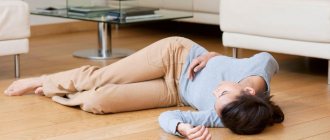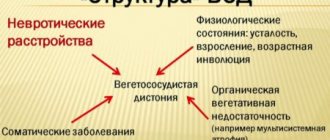Dizziness is a distorted perception of the position of one’s body in space, in which there is an imaginary sensation of movement of either the body or space. This symptom occurs in many diseases and has no specificity. Dizziness can accompany somatic, neurological and mental illnesses. This disorder is sometimes called "vertigo", but this is a somewhat outdated expression.
Dizziness is almost always detected with VSD or neurocirculatory dystonia.
Treatment of numbness, tingling, burning sensations
Often after stress or during neuroses, people feel a feeling of numbness, burning, tingling in their arms, legs or head.
this may be accompanied by a sensation and actual coldness of the extremities, arms or legs, and a feeling of chills. Such manifestations occur as a result of autonomic dysfunction at the time of breakdown of nervous activity. These sensations may have a temporary, passing effect. And it happens that such sensations are protracted and begin to reduce a person’s quality of life. In such situations, you should already contact a specialist for treatment. Brain Clinic specialists have extensive experience in treating various disorders of nervous activity. Our doctors will be able to correctly and safely restore the body’s functioning without any side or negative effects on it.
Call
We help in the most severe cases, even if previous treatment did not help.
Ways to get rid of hypochondria
Unfortunately, there is no cure for this disease. There are a number of drugs that help drown out feelings of anxiety and fear and lift your mood. As a rule, this list includes simple sedatives, mild antidepressants and tranquilizers, and for anxiety disorders - anxiolytics. Each of the drugs should be prescribed after a full medical examination. After studying the tests and conclusions, the doctor decides which medications and in what dosage to prescribe to the patient. Most types of antidepressants and anti-anxiety medications are available by prescription only.
Psychotherapy remains the most effective treatment method. An important point is to clarify the problem that influenced the development of hypochondria. After identifying the problem, the psychotherapist must carefully and unobtrusively explain to the patient that his illness is a purely psychological phenomenon and does not in any way affect the functioning or disease of the internal organs.
Sometimes the psychotherapist fails to identify the cause of the disease during a conversation. At such moments, doctors resort to hypnosis. By putting the patient into a hypnotic sleep and allowing them to remember the most insignificant moments from life, they quickly find the cause of the development of hypochondria. And, therefore, they can more accurately say what needs to be changed or done to get rid of the problem.
Also, one of the methods of struggle is to change the situation and activity. Often, “sick people” are helped by a long vacation in the forest, mountains or on the seashore. A calm atmosphere and lack of stress helps them escape from worries about health and relax or care for loved ones. It is important that relatives, understanding the problem, protect the “patient” from stress and anxiety.
Manifestations of tingling, burning, numbness sensations
Along with these sensations, as a rule, other symptoms associated with a disorder of higher nervous activity may appear, such as decreased mood, sleep disturbance, causeless anxiety, internal trembling, as well as the following:
Often accompanying symptoms of numbness, burning, tingling
Causes of feelings of numbness, burning, tingling
Feelings of numbness, burning, tingling in various parts of the body, which can be due to various reasons.
- if a person has been in the same position for a long time, any part of the body may become numb,
- the situation can occur after long periods of heavy, tiring physical activity,
- if there is a lack of any microelements,
- may be an indicator of various vascular diseases,
- numbness, burning, tingling in various parts of the body can be associated with serious diseases caused by organic lesions of the central nervous system (for example, polyneuropathy is a fairly common disease in severe forms of alcohol addiction); - the most common sensations of numbness, burning, tingling manifests itself in various borderline mental states and are included in such syndromes as: neuroses, anxiety disorders, depression, etc.
What should you not do during attacks?
These actions can greatly aggravate the course of the attack or add new terrible symptoms to it.
- You can't take strong drugs. You cannot prescribe drugs to yourself. You should not take adrenergic blockers, especially if you have an attack of VSD after drinking alcohol.
- If there is no blood pressure monitor nearby and you doubt your blood pressure, you should not drink coffee or strong tea. These drinks can increase blood pressure and anxiety even more.
- There is no need to try to relieve attacks with increased physical activity. Only moderate activities are allowed. Any overexcitation will only add adrenaline to the blood, and the attack will play out with renewed vigor.
- Under no circumstances should you lie down in a hot bath or take a hot shower.
If you are lucky enough to have a stable nervous system, never try to judge a VSD person for being childish or “crashing nonsense into himself.” The caustic remarks of loved ones, coupled with the most terrible internal suffering, can lead a person to deep depression and forever change his life for the worse.
Believe me, the VSD person is in a painful state, and you cannot blame him for the fact that in a certain situation he is not able to pull himself together like you. This is perhaps the most important rule if you are really going to help a person.
Diagnosis of numbness, burning, tingling sensations
If a person, at some point, begins to worry, his quality of life deteriorates, he begins to visit doctors of various specialties. And if doctors rule out somatic pathology, then an in-person joint consultation with a psychotherapist and a neurologist is necessary, since these sensations are more common with any disorders of the nervous system.
The sensation of numbness, burning, tingling in various parts of the body is a consequence of disruption of the autonomic nervous system. As a rule, such sensations are quite common in anxiety-neurotic syndromes complicated by autonomic reactions (disruption of higher nervous activity) and various neurological changes. At the biological level, the central nervous system gives the wrong impulse to the peripheral nervous system, and these unpleasant sensations appear, which destabilize the person’s mental state even more. The person begins to worry about what perpetuates this pathological reaction of the nervous system. It turns out to be a “vicious circle”.
Also, numbness and tingling in various parts of the body can be a pathology of sensations in the form of so-called senestopathy. The unpleasant, painful, sometimes unusually painful affective tone of the sensations of senestopathies, as a rule, is consonant with an anxious-depressive mood. These sensations are long-lasting, occur in short bursts and are always difficult for people to bear.
It is very important to note that the occurrence of senestopathies is not associated with local disorders, which can be established by standard diagnostic research methods.
As a rule, at the onset of the disease, with manifestations of senestopathy syndrome, sensations most often have a certain localization and similarity to the manifestations of general somatic diseases. Subsequently, these sensations lose their strict localization, become diffuse, and acquire an unusual, and often pretentious, character.
The above disorders in the form of numbness or tingling in various parts of the body can be symptoms of various mental disorders, ranging from neurotic disorders to severe psychotic illnesses.
If we are talking about an anxiety-neurotic disorder (a breakdown of higher nervous activity), then, as a rule, neuroses are borderline mental states and, with adequate therapy, they are reversible and the prognosis is quite good.
To accurately determine the condition, you need the correct diagnostic basis and consultation with a psychotherapist, who, using the results of the examination, will be able to prescribe treatment; as a rule, complex therapy is needed here:
- medicinal, to restore the biological functions of the brain,
- psychotherapy in order to destroy pathological behavior patterns and recreate healthy ones.
Most often, patients with disruptions of higher nervous activity complain of numbness in the extremities, part of the head (especially the scalp), fingers and toes.
The tingling sensation most often occurs in a less localized area of the body and is described by patients, in most cases, as “tingling here and there.”
Example of patient complaints of tingling sensations and feelings of numbness
Such complaints are the most common in the practice of modern psychotherapists and neurologists.
Male, 35 years old. Married, has a prestigious job, no bad habits. I was examined by almost all doctors and got an appointment with a psychotherapist by accident.
For example, we specifically chose a case that does not have a somatic connotation in the form of the consequences of any diseases, for example, alcoholism, drug addiction, vascular changes, brain injuries, etc.
In this case, the manifestation of the patient’s complaints is based on a disruption of higher nervous activity as a result of high psychophysical stress, since these are the patients who make up the largest number among those seeking medical help with similar symptoms.
The patient had a large folder with him with various studies and test results. He came to the appointment accompanied by his wife, who insisted on his conversation with the doctor. His attitude towards the conversation with the psychotherapist is extremely negative.
“I came to you at the insistence of my wife, although I don’t understand how my goosebumps and lack of sensitivity in the back of my head can be related to psychiatry. I know for sure that I am mentally healthy and I have a certificate from a psychiatrist. I have a driver's license and I have a gun." ...
The patient could not calm down for a long time and did not want to have a constructive conversation with the psychotherapist. But, after some time, the doctor finally convinced him to complain about his condition and together figure out the reasons for the decline in his quality of life.
“It started when I began to feel a tingling and pinching sensation in my arm. At first I thought that I was sleeping incorrectly. Then it began to be felt more and spread to the neck and face. It feels like they are being pricked with small needles. It doesn't hurt, but it's very annoying and distracting. I went to the therapist, donated blood for lipids, coagulation, biochemistry, etc. and everything turned out to be normal, so he sent me to a neurologist.
The neurologist sent me first to an MRI, then to an EEG, CT, and ultrasound. Diagnosed with: polysegmental osteochondrosis, scoliosis, functional instability of the cervical spine, vertebral artery syndrome against the background of polysegmental osteochondrosis, Vertebrogenic dorsalgia, narrowing of the vertebral arteries with insufficiency of blood flow of 60%. He prescribed treatment, which I took for 8 months. The result, if you say that it is zero, then this is not true, because it got worse, which is also a result. During this time, the back of my head began to go numb, and goosebumps spread to my stomach. I quit treatment with this neurologist and went to another one. Another made his own diagnosis (transient ischemic cerebrovascular accident), and the result was the same, I went to another - compression of the left vertebral artery in the precranial segment with a local hemodynamic shift at the level of the Atlanta loop, stenosis less than 50%. Then to another, and another. In total, I visited six neurologists who diagnosed me and treated me, but nothing changed, except that the area of numbness on the back of my head grew, and I no longer felt half of my head, and I began to feel tingling sensations in different places.
Treatment of vegetative-vascular dystonia (VSD)
Treatment of vegetative-vascular dystonia is a rather lengthy and painstaking task.
A positive prognosis largely depends on correct diagnosis and accurate determination of the cause of VSD. Treatment of VSD is carried out comprehensively and includes the following points:
- Normalization of daily routine, sleep, rest;
- Elimination of physical inactivity using dosed physical activity (PT);
- Therapeutic massage and water procedures;
- Balneotherapy (treatment with mineral waters);
- Phototherapy;
- Limiting sources of emotional experiences - computer games, TV shows;
- Counseling and family psychological correction;
- Normalization of nutrition (regular consumption of food enriched with vitamins);
- Electrophoresis;
- Drug therapy.
Read also Flux (periostitis). Description, symptoms, causes and treatment of flux
Work/rest mode
Each person’s body has its own specific “charge”, which depends on many factors. When the strength runs out, but a person continues to overload his body with physical or mental work, the body begins to weaken, thereby being subject to various imbalances in the functioning of certain systems. The same thing happens if a person does not give the body enough time to rest. Therefore, to maintain health, it is very important that a person maintains a work/rest schedule. Work in moderation, rest and be sure to get enough sleep.
Physical inactivity or sedentary lifestyle
A sedentary lifestyle leads to weakening of the muscle tissue of certain organs that are least involved in a person’s daily life. In addition, physical inactivity increases the risk of developing various diseases of the cardiovascular system. “Movement is life”, this is a fair saying. The more a person moves, the better the blood “plays”, thereby improving blood circulation, the organs receive with the blood the nutrition necessary for their normal functioning in the form of oxygen and various substances.
Therapeutic massage and water treatments
Physical effects on the body, in particular therapeutic massage and water procedures, improve blood circulation, improve the functioning of the lymphatic system, if necessary, restore the structure of the spine (in the case of osteochondrosis), and along with the spine, the nerve channels with the vessels that pass through it are aligned. In addition, massage allows you to relax, relieve stress, and improve muscle tone. All these actions have a beneficial effect not only on the functioning of the central nervous system, but can also improve the overall health of a person.
Sources of emotional experiences
The modern number of media, as well as ways to obtain this information, is only growing from year to year. Today, few people will be surprised by a smartphone with the ability to get information from the Internet, a computer, a laptop, or a TV. But the whole problem lies in the quality of the information received. If you make a short review of at least posters for certain modern computer games, some cartoons, movies, news, then you can highlight the overall picture - murder, violence, cruelty, lies, wars, the occult, etc. All this has an extremely negative impact on the developing psyche of the child, and on many people as well. Bad dreams, selfishness, disrespectful attitude towards other people are just the tip of the iceberg. The basis is emotional instability, imbalance, uncertainty about the future, panic fears. If you are a parent and have not yet studied the flow of information that feeds your child, this is the time to start doing so. Protect your child from the negative flow of information from the Internet and other sources. This is a very important point not only from a therapeutic VSD point of view, but also as a preventive measure against other complex diseases that usually manifest themselves in an adult.
Family psychological correction
This measure is necessary if your family experiences frequent conflicts and difficulties raising a child. Remember, quarrels and scandals have a negative impact on the mental development of a child. Do not allow a showdown in front of the children. Children should grow up in a loving family where each member respects each other. In this way, a person is cultivated who will follow your family model, and it is better for the family to be happy.
Nutrition
For the normal functioning of any human organ or system, various vitamins and minerals are required. Each vitamin is involved not only in the functioning of the entire body, but also in the development of all organs and regulation of their vital functions.
Some of the vitamins are produced in the required quantities by the body itself, but basically, we can only get vitamins from the food we eat. If a person gets used to eating fast food, sandwiches, chips, beer and other low-health foods, he does not receive the required amount of vitamins, because These foods simply don’t contain them. It's tasty, perhaps, but it's certainly not healthy. Moreover, such junk food is harmful to human health. It is also extremely important to eat at least 3 times a day. Food is a kind of “energy” that is necessary for a person to perform various daily tasks. There is no food, or it is incomplete, there is no strength for work, and of course, human health.
Give preference to foods rich in vitamins and minerals - vegetables, fruits, herbs, cereals. Try not to fry foods, but to steam or boil them. The less you heat treat your food, the more vitamins and microelements they will retain. Human beauty and health largely depend on human nutrition.
Electrophoresis
For vagotonia, electrophoresis with caffeine, calcium, and mesatone is prescribed. For sympathicotonia, electrophoresis with magnesium, papaverine, bromine, aminophylline is prescribed.
Drug therapy
Drug therapy is usually used in the following cases:
- Non-drug therapy did not bring the desired result;
- To relieve various kinds of symptoms that make it difficult to perform daily tasks;
- For the treatment of various chronic diseases that may be factors determining the development of VSD.
Medicines for VSD:
Sedatives. They have a beneficial effect on the nervous system and calm. Among the sedatives widely used: preparations based on valerian, hawthorn, St. John's wort, motherwort - "Novopassit", "Persen", "Stressplant", herbal tea with lemon balm.
Tranquilizers (anxiolytic drugs). Used to relieve attacks of fear, stress, and anxiety. Among the tranquilizers you can find Relanium and Tranxen.
Antidepressants. They are used to relieve feelings of depression, depression, apathy, anxiety, irritability, emotional stress, as well as to increase mental activity. In addition, antidepressants are used in cases where a patient with VSD constantly feels aches and pains throughout the body (in the heart, gastrointestinal tract, muscles and joints), which are not amenable to symptomatic treatment. Antidepressants include: Amitriptyline, Imipramine, Clomipramine, Coaxil, Prozac, Cipramil.
Read also Adnexitis - symptoms, causes, types and treatment of adnexitis
Nootropics. They are used to improve mental activity, brain resistance to various stressful situations, and improve the energy state of neurons. Among the nootropics we can highlight: “Pyritinol”, “Piracetam”, “Phenibut”.
To normalize peripheral and cerebral circulation, as well as blood microcirculation, the following are used : Cinnarizine, vinpocetine (Cavinton), pentoxifylline (Trental), nicotinic acid (vitamin B3 or PP).
For sympathicotonia and pain in the heart area, beta-blockers are used - propranolol (Anaprilin, Obzidan), Atenolol (Atenol, Tenormin).
To relieve heart pain, the following is used: Verapamil (“Verapamil”, “Isoptin”), “Valocordin”, valerian tincture.
With vagotonic reactions. Psychostimulants of plant origin are used - preparations based on Schisandra, Eleutherococcus, Zamanikha, etc.
For intracranial hypertension (high blood pressure), dehydration therapy is used, which is aimed at removing excess water from the body. Diuretics are used for these purposes.
In combination, glycine, glutamic acid, pantogam, and complexes of vitamins and microelements have proven beneficial in the treatment of VSD.
For constipation, you need to add food with plenty of fiber, fresh vegetables and fruits to your diet. It is also allowed to take laxatives: Duphalac, Lavacol, Normaze.
With frequent diarrhea , the amount of fiber consumed in food must be reduced. Additionally, you can take an antidiarrheal agent: loperamide (Imodium, Lopedium), sorbents (Polifepan, Smecta).
At elevated temperatures, you can take: “Pirroxan”, “Phentolamine”.
In case of increased sweating , the skin can be treated with solutions of formaldehyde, potassium permanganate (potassium permanganate), tannic acid.
In case of venous insufficiency - if the patient has noise in the head and throbbing pain in it, heaviness in the head, you can take: "Vasoket", "Detralex". Medicines for venous insufficiency are taken for 1-2 months.
For dizziness due to high blood pressure, drugs that improve cerebral circulation are used - Vinpocetine, Cavinton, Nicerium, Oxybral.
For severe headaches and dizziness, you can take Betaserc.
Important! During treatment for VSD, be sure to give up bad habits - smoking, drinking alcoholic beverages, taking drugs.
Forecast
With timely detection, accurate diagnosis and strict adherence to the doctor’s instructions for the treatment of VSD, the prognosis for recovery is favorable. In case of VSD, it is very important to correctly carry out psychological adjustment of the child, so that after he grows up, the mental deviations formed during VSD do not accompany him throughout his life.
Treatment of numbness, burning, tingling sensations
The treatment for this case lasted for three months, after which all symptoms disappeared completely, numbness and tingling no longer appeared. My sleep has become high quality, there are no headaches or dizziness. The meaning of what was said is grasped immediately. It is recommended to contact immediately if your condition worsens. In addition, an annual inspection is required. The patient was observed by our doctor for 4 years and followed the recommendations in full. During this period, no deterioration of the condition was recorded.
As a rule, treatment in such situations is always justified by the reasons for the formation of these sensations, which are indicated in a complete and accurate diagnosis. Treatment is recommended to be carried out in an outpatient program using hospital-substitution methods. Treatment for sensations of numbness, burning, tingling should be active, using neurometabolic agents, methods of restorative therapy of the nervous system, psychotherapy, and possibly the use of physiotherapy. It is necessary to strictly follow the doctor’s recommendations regarding daily routine and diet.
If another stressful situation occurs during treatment, exacerbations may occur and the condition may worsen. However, inpatient treatment is usually not recommended for patients so that their nervous system is “trained” to respond correctly to such adverse external influences. This is the main goal of treatment - to prevent another nervous breakdown.
Inpatient treatment for symptoms of numbness, burning, and tingling can only be recommended if these manifestations are in the context of an acute mental state (psychosis).
Numbness, burning, and tingling sensations can be felt in various parts of the body
- sensation of numbness, burning, tingling in the scalp
- feeling of numbness, burning, tingling in the hand
- sensation of numbness, burning, tingling, tickling of the tongue
- feeling of numbness, burning, tingling in the legs
- numbness, burning, tingling sensation in the face
- sensation of numbness, burning, tingling in the fingers
- sensation of numbness, burning, tingling in the mouth
- sensation of numbness, burning, tingling, tickling in the throat
If you feel numbness or tingling sensations in various parts of the body for no apparent reason
You don’t need to undergo a lot of unnecessary tests
Call and make an appointment! Our treatment helps even with the most severe cases, when other treatments have not helped!
numbness of the extremities
It all started with attacks of sudden blackout. For 1 second I feel like I’m losing consciousness, without dizziness, without tinnitus (not like collapse). The first attack was in a car while driving. The second is when leaving the house. The third attack was stronger with weakness, a feeling of weakness in the limbs and a feeling that I was falling. It was in the store. And then everything is pretty much the same.
There is severe tension in the back of the head, changing position does not bring relief, does not relax, sometimes on the contrary, if you lie down with tension, it will be worse. Constriction of the head. Anxiety. I am constantly afraid that I will die. At the same time, due to polyvalent allergies, I am terribly afraid of all medications. Internal trembling. If you get nervous, then after a couple of hours there may be trembling in the body. It is often difficult to breathe. The heart tenses. I'm constantly afraid of fainting. It often seems that consciousness goes away and squeezes the head. I never had a severe headache. It’s very uncomfortable in the car and on the street, there’s a lot of tension. There is no dizziness like on a carousel. More like an internal spinning. Over the last week, numbness has appeared. Then my left leg went numb from the hip to the foot. I did not completely lose sensitivity and could walk calmly. Feeling like needles are running down your leg. Then a feeling of numbness appeared in the left side (where the ribs are last from the back). After nervous tension yesterday, numbness appeared in the fingers of my right hand (as the local anesthesia wears off). I had a hard time falling asleep at night. It seemed like I was losing consciousness. The right side began to go numb on the right side, and the left side went numb on the left side. I slept 2-3 hours at night. In the morning I woke up and everything seemed OK. I went to bed for 2 hours. I woke up with numbness on the left side of my body (exactly to the left from the shoulder to the heel, like needles were running). Weakness in the body. Shiver. The desire to disconnect. Consciousness is strange. It's hard to concentrate. Everything was annoying. During the day my head was heavy. I called an ambulance and they looked and said it wasn’t a stroke or a heart attack. It got worse when lying down, my heart seemed to jump out. I couldn’t walk much because I felt weak and felt like I was falling. By the evening I was distracted and it seemed to be better, only numbness. From the examinations completed: Blood - everything is fine, only anemia. I’ve been taking tardiferon for 2 weeks; ferritin was 10, became 16, hemoglobin was 119, became 127. Thyroid hormones are normal. MRI of the brain there are no formations in the brain. MR picture of a few supratentorial foci and foci of gliosis of vascular origin (microangiopathy, probably of a residual posthyposkic nature), slightly pronounced external-type liquorodynamic changes. MRI neck protrusion 1-2 mm. Ultrasound of neck vessels without pathologies. The ophthalmologist was fine (having seen me in my condition, he sent me to a psychiatrist) I only saw the EEG conclusion. No pathologies.
Diagnosis of neurotic and somatoform disorders
The signs of a neurotic disorder are variable and imprecise; each person’s neurosis can manifest itself differently. Therefore, in order to accurately establish a diagnosis and receive adequate treatment, you need to consult a psychotherapist.
A psychotherapist diagnoses neurosis. The treatment regimen that will help cope with the disorder depends on the type of neurosis and its severity.
Neurosis is a functional disease of the nervous system. This means that the disorder occurs temporarily; there is no infection, tumor, or persistent pathology of blood vessels or internal organs in the body. Negative factors deplete the nervous system:
- stress;
- overvoltage;
- internal conflict;
- traumatic situation.
This causes disturbances in the functioning of the heart and blood vessels, indigestion, strange pain and discomfort in different parts of the body. Somatologists (who deal with diseases of the body - therapists, neurologists) do not find any abnormalities: neither peptic ulcers, nor abnormalities of the endocrine system (for example, the thyroid gland), nor inflammation.
Manifestations of neurosis in adults are often confused with other diseases, so most patients undergo examinations for years, but treatment does not produce results. In such cases, it is recommended to consult a psychotherapist.
The body is healthy with neurosis, most tests are normal. “All diseases come from nerves” - that’s exactly what it’s about.
How to recognize neurosis? It is characterized by the following symptoms:
- somatic manifestations (from the body) - vague pain, increased fatigue, changes in blood pressure, fever, sweating;
- emotional instability - frequent unreasonable or causeless anxiety, fear, irritability, tearfulness;
- poor load tolerance - a person cannot concentrate, sometimes cannot sit still. Both work and personal life suffer; basic tasks become tiresome very quickly.
In the next part we will take a closer look at how neurosis manifests itself and what specific symptoms and complaints are possible.
How to define neurosis
Symptoms depend on the form of neurosis. The most common manifestations of the body and psyche are:
- sleep disorders;
- indigestion;
- breathing problems, feeling of suffocation;
- disruption of the heart and blood vessels;
- vegetative symptoms - trembling, convulsions, sweating, temperature changes, even pain.
One of the first possible signals is sleep disturbances. Difficulty falling asleep, shallow or restless sleep, frequent awakenings. The feeling of tension in the head during neurosis is a consequence of the fact that at night the nervous system is not fully restored. Sleep disorders lead to constant tension and emotional breakdowns.
The digestive system is sensitive to psychological traumatic factors. She reacts with loss of appetite, flatulence, frequent pain and discomfort in the abdomen, and problems with stool. In this case, the person has neither an ulcer nor an intestinal infection. A common manifestation is nausea during neurosis, which is accompanied by a feeling of dry mouth.
The nervous system is connected to all internal organs, so with neurosis the entire body suffers. The opposite is also true: if you give a specialist the opportunity to cure the psyche, the physical symptoms will also disappear.
With neuroses, there are breathing problems: typical complaints are lack of air, difficulty inhaling or exhaling, and suffocation. Sometimes a person feels like he has forgotten how to breathe. It is often observed when you find yourself in a conflict or emotionally significant situation.
From the cardiovascular system, hypertensive crises, heart rhythm disturbances, and discomfort in the chest area may be observed. Tachycardia with neurosis is a common complaint.
The nervous system takes the main “blow” under constant stress. A person experiences tremors in the body during neurosis, frequent headaches, hot flashes, muscle cramps, changes in sensitivity (numbness of the limbs). Sometimes he may complain that he feels dizzy for no reason.
All changes in neurosis are functional, that is, reversible. With adequate treatment, patients recover completely.
Mentally, a person becomes depressed, cannot concentrate for a long time, and memory decreases. The level of anxiety increases, and overly violent emotional reactions are possible. With psychoneuroses, there are no hallucinations, but sometimes there is tinnitus.
If it is necessary to sit quietly for some time, a person with neurosis experiences discomfort. To calm himself down, he begins to tap his pen, play with an item of clothing, and fidget with his fingers.
Feeling faint
The feeling of some lightheadedness that occurs when the vestibular apparatus malfunctions is one of the most common complaints among people of all ages. The sensation is accompanied by general weakness of the body, lethargy, some intoxication and dope in the head. In this case, the patient may sway violently, and disturbances in general coordination of movements are accompanied by a state close to fainting. In uncertain cases, the patient is asked to breathe deeply, and at the same time the feeling of lightheadedness, which is a characteristic sign of the onset of dizziness, is most clearly manifested.
Similar sensations can occur in numerous disease states, such as severe anemia, complex lung diseases, and orthostatic hypotension. Such symptoms are typical for patients who have recently completed a course of taking antihypertensive drugs, who have recently been on bed rest, as well as in older people, even if they have no other complaints. When you rise sharply from a sitting position, a stupefying feeling may occur, which completely disappears after a few seconds. In this case, the patient has difficulty maintaining his balance.
Attacks of lightheadedness
Attacks of lightheadedness can occur suddenly and for no apparent reason. The main reason lies in the fact that in stressful situations, hormones and active substances are released into the human blood, helping to remove a person from an equilibrium state. At the same time, the eyes may darken, a ringing may appear in the ears, and a general feeling of weakness may arise. These are the most common symptoms of lightheadedness that occur in apparently healthy people.
Psychoneurosis: symptoms and reasons for contacting a specialist
Frequent suppression of negative emotions and life in constant stress lead to prolonged psychoneuroses. It can be extremely difficult to get out of them without qualified help.
A person can be tormented for years by chronic neurosis, the symptoms of which are emotional “breakdowns” (hysterics, tears, irritability) or physiological reactions (stupor, loss of voice, pressure surge, nausea) to a small conflict or difficulty. A person is simply not able to control behavior and emotions at a difficult moment.
If a therapist, cardiologist, or gastroenterologist did not find anything, do not forget to seek a diagnosis from a psychotherapist.
Often, in attempts to alleviate the condition or find out the cause of constant discomfort, people find imaginary illnesses due to neuroses. This is characteristic of the somatoform form of the disorder. A person undergoes all possible tests and undergoes absolutely all examinations. The burning sensation of the skin or weakness in the legs (sometimes even the slightest sensation in the body) characteristic in some cases of psychoneurosis is perceived as a symptom of a terrible, fatal disease.
This disease is reversible, but contacting a psychotherapist is an important step towards recovery. A neurotic disorder worsens relationships with family, creates problems at work, and leads to self-destructive behavior (alcohol, drugs, attempts to die).
The reason for contacting a specialist may be a violation of the thermoregulatory function of the body - simply put, an increase in temperature due to neurosis. In another way it is called thermoneurosis. Here it is important to exclude other diseases, so you can also consult a neurologist.
Causes of numbness during VSD
In addition to traditional headaches, blood pressure fluctuations and emotional lability, typical signs of VSD include numbness of the limbs or a feeling of “pins and needles”.
The appearance of these symptoms is accompanied by various diseases - multiple sclerosis, diabetes, strokes. But if we consider the problem of vegetative-vascular dystonia, then sensitivity disorders are based on 3 main factors:
- Microcirculation disturbance. Against the background of the development of VSD, a disorder of the blood supply to peripheral tissues occurs. The vessels do not fully cope with their function. Because of this, the cells do not receive enough nutrients and do not function properly.
- Functional disorder of innervation. This leads to disturbances in the process of impulse transmission with the appearance of characteristic symptoms.
- Hyperoxia, or “poisoning” of the blood with oxygen. This phenomenon is characteristic of panic attacks, when a person breathes quickly and deeply. In this case, numbness occurs in the tips of the fingers, lips, and face.
In addition to these reasons that cause numbness in the arms or legs during VSD, one must not forget about the general disorder in the functioning of the autonomic nervous system (ANS).
If your limbs go numb, you don’t need to panic right away. Such a reaction will lead to further deterioration of the condition. The doctor will help you understand the causes of the problem and help you get rid of unpleasant symptoms.
Worsening of the disease due to numbness
In itself, numbness of the arms or legs due to VSD does not pose a threat to health. Of course, this symptom cannot be called pleasant, but it also cannot lead to terrible consequences.
There is a separate contingent of extremely suspicious people who try to monitor their health as closely as possible. They know about their problem, but when numbness of the limbs appears, they do not always understand the reasons for the occurrence of such a symptom and begin to panic even more.
Against this background, negative thoughts begin to appear. For example, they worry about:
- the disease began to progress too actively;
- VSD transformed into another more serious pathology;
- infection has joined;
- cancer develops.
If, in addition, a person uses the Internet and constantly looks for information about the meaning of certain symptoms (taken out of the context of the overall clinical picture), then soon he will give himself a couple of disappointing diagnoses.
Due to worries about health, the pathological effect of stress on the ANS, and a decrease in the body’s adaptive forces, the general condition worsens. The result of this is a worsening of VSD with even greater progression of numbness of the limbs.
Thus, a “vicious circle” is closed. But it’s enough just to see a doctor in time.
Who is most susceptible to the disease?
In medical statistics, hypochondria occurs equally in men and women. Most often it appears at the age of 40-60 years, as well as in adolescence. In adolescents, this phenomenon is caused by hormonal surges, changes in the body and psychological state. Changes in appearance and character bother children and they often develop hypochondria. At such moments, they listen with special attention to the slightest discomfort. This leads to the fact that a slight tingling sensation can develop into acute pain.
It is also not uncommon for the disease to be detected in students. The presence of a heavy workload, constant stress and disruption of the usual daily routine can easily cause hypochondria. The disease subsides upon graduation.
The people most susceptible to this type of disease are emotional people. In addition to banal stress, the development of hypochondria is facilitated by flows of information about new diseases, statistics on people suffering from AIDS and oncology. Fear for one's health is the impetus for the development of a constant feeling of anxiety and concern for one's life.
Numbness options
People who suffer from numbness in their limbs may describe their sensations in different ways. Let's start with the fact that the problem can have different localization. The hands are most often affected, but skin numbness also occurs on:
- legs;
- face;
- occipital region;
- back (extremely rare).
In addition, paresthesia is often accompanied by a characteristic “crawling sensation” or heaviness in the legs. The last symptom is associated with disorders of the regulation of the outflow of venous blood from the lower extremities, which leads to its stagnation.
Regardless of how the numbness manifests itself, it is important to monitor its progress, find out the exact cause of the problem and choose the right treatment. Only the attending physician will help with this.
Differential diagnosis
Numbness of the limbs or other changes in tactile, pain and temperature sensitivity are caused not only by VSD. To select the right treatment method, it is important to find out the exact cause of the symptom.
In addition to disorders in the functioning of the autonomic nervous system, other diseases cause a similar clinical picture:
- Radiculitis is a local inflammation of the spinal nerve roots. Most often it manifests itself as pain at the origin of the fibers in the spine, but is sometimes accompanied by numbness of the limbs.
- Protrusion or herniation of an intervertebral disc, especially in the lumbar region. If the hernia causes compression of the sensory roots, then it is possible to develop a sensitivity disorder of the radicular type, when the areas of paresthesia resemble narrow or wide stripes in the form of stripes.
- Carpal tunnel syndrome. Against the background of prolonged and monotonous brush work, a disorder of innervation with the appearance of characteristic sensations is noted.
- Syndrome and Raynaud's disease. Pathology caused by impaired vascular contractility with the appearance of cyanosis of the skin, paresthesia and coldness of the extremities.
- Hypovitaminosis of group B. These biologically active substances are responsible for metabolism in nerve fibers, and their deficiency is manifested by a corresponding clinical picture.
- Ischemic and hemorrhagic stroke. A terrible disease, the symptoms of which include paralysis and sensitivity disorders.
- Obliterating endarteritis. Vascular disease, accompanied by impaired blood supply to tissues and the appearance of a corresponding symptom.
- Various forms of neuropathies - diabetic, infectious, traumatic or other types of damage to nerve fibers in the area of innervation of the limbs also cause numbness and other changes in sensitivity.
Please note that the organic causes of numbness are listed above. In each case, there is a certain pathological mechanism that leads either to hypoxia of neurons, or to their necrosis, dystrophy, and circulatory disorders.
All these diseases are treated over a long period of time, but with vegetative-vascular dystonia we are talking about functional disorders that resolve quickly enough. The main thing is to make the correct diagnosis in time and prescribe treatment.
Only a doctor at the appointment and using additional diagnostic methods will determine whether the appearance of “goosebumps” and numbness is the cause of VSD alone or whether another disease has been added.
Drug treatment
If it is determined that the cause of numbness in the limbs is a dysfunction of the ANS, then the following are more often used:
- multivitamin complexes with the obligatory presence of group B;
- metabolic therapy products that improve metabolic processes;
- vasodilators;
- stimulants (for hypotonic form of VSD).
Other medications are also used, especially if vegetative-vascular dysfunction occurs against the background of diabetes mellitus or obesity. In this case, to restore sensitivity, additional administration of alpha-lipoic acid drugs is necessary:
Dizziness
Headaches, nausea, causeless fatigue, weakness, dizziness are frequent companions of vegetative-vascular dystonia. The manifestation of VSD can be provoked by:
- Heredity.
- Chronic diseases (diabetes mellitus, others).
- Diseases of the nervous and cardiovascular systems.
- Disturbances in the functioning of the thyroid gland, adrenal glands, and other glands.
- Stress, constant nervous tension, overwhelming mental stress, etc.
If you feel dizzy during VSD, you stagger when walking on the street, in some cases it becomes difficult to breathe when you feel dizzy, this indicates serious abnormalities. There is no need to self-medicate or wait for the disease to go away on its own; you should urgently seek advice from a specialist.
Non-drug treatment
It is possible to influence the autonomic nervous system and combat numbness of the limbs without taking medications.
Here are some ways to improve your well-being:
- Yoga is a set of physical, psychological and spiritual practices that harmonize the body’s functioning and eliminate the symptoms of vegetative-vascular dystonia.
- Contrast shower is a physiotherapeutic technique for training the body’s blood vessels against the background of alternate use of warm and cold water.
- Dosed physical activity. A properly selected set of exercises will improve blood circulation and innervation. Due to this, it will be possible to quickly and reliably get rid of numbness in the limbs.
Thus, changes in sensitivity in the arms, legs and other areas that occur with VSD are not dangerous. But to prevent the deterioration of the condition, it is necessary to fight them with all methods, and we must start with normalizing the lifestyle and improving the health of the body.
Prevention
The occurrence of paresthesia cannot always be prevented. But there are still preventative measures that will help effectively reduce the frequency of attacks, namely:
- using special wristbands to reduce pressure on the nerve (during sleep);
- avoid the same type of movements;
- take breaks and rest more often;
- carefully monitor your health (especially if you have diabetes or another chronic disease);
- completely eliminate the use of alcoholic beverages;
- create a complete daily diet (small meals, avoid overeating);
- monitor blood pressure indicators;
- lead a healthy lifestyle;
- strictly adhere to the daily routine.
Following all these rules will significantly reduce the risk of developing paresthesia and improve overall comfort in life. You will forever forget about tingling in your legs and other unpleasant symptoms. And goosebumps will appear on your legs only from pleasure.
There is no equipment or tests to make a diagnosis of VSD. Therefore, doctors have to act almost by elimination. First, the presence of somatic, neurological and endocrine disorders is checked. Depending on the patient’s complaints, diseases with similar manifestations are excluded. If they are not present, then based on the totality of symptoms, a diagnosis is made - dystonia of the autonomic nervous system.












